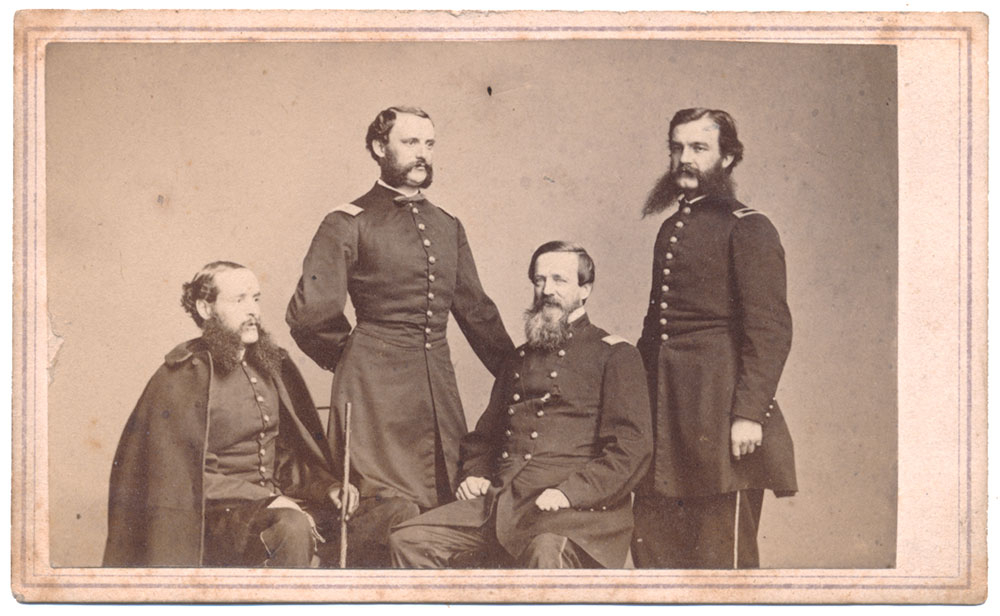site search
online catalog
SEATED VIEW OF COLONEL DAVID HUSTON JR OF THE 11TH US REGULARS SURROUNDED BY HIS STAFF – RICHMOND PHOTOGRAPHER

$225.00 SOLD
Quantity Available: None
Item Code: 160-446
CDV shows Houston seated at center of four other officers who are assumed to be members of his staff. Two of the officers are sporting some wild chin whiskers and one wears a cape while the rest are in regulation uniforms.
Contrast and clarity of the image are excellent. Paper and mount have light edge dirt.
Reverse has a photographer’s imprint for ANDERSON & CO’S…RICHMOND, VA.
Daniel Huston Jr was born in Maine in 1824. He entered West Point as a cadet in 1843 and graduated in 1848 with the brevet rank of 2nd lieutenant in the 8th U.S. Infantry. He was fully promoted to 2nd lieutenant the following year and transferred to the 1st U.S. Infantry. On December 8, 1856, he was promoted to captain.
When the Civil War began Captain Huston served with the 1st Infantry in Missouri, fighting at the battle of Wilson's Creek. On August 10, 1861, he received a brevet rank of major for his services at Wilson's Creek. Huston's most notable role in the war came on February 21, 1862, when he was appointed colonel of the 7th Missouri Cavalry Regiment. A detachment of the regiment fought at the battle of Lone Jack but Huston was not personally involved.
By the winter of 1862 Huston's regiment was part of the 2nd Division of the Army of the Frontier. The regular commander of the 2nd Division, Brig. Gen. James Totten, was called to testify in court at St. Louis and Huston found himself as senior officer in the entire division. Huston led the 2nd Division at the battle of Prairie Grove where it was attached to Brig. Gen. Francis J. Herron's command. Huston's men made an initial charge against a Confederate battery near the Borden House early in the fighting.
Huston remained in command of the 2nd Division for a short while after the battle of Prairie Grove before reverting to his regular army command in the 1st U.S. Infantry. There he participated in the Vicksburg Campaign and was awarded a brevet promotion to lieutenant colonel and later, on August 1, 1863, was promoted to major of the 11th U.S. Infantry. On December 30, 1864, he was mustered out of the volunteer service but continued to serve in the regular army. At the end of the war the 11th did Provost Duty in Richmond.
Huston was promoted to colonel of the 5th U.S. Infantry on February 6, 1882, and retired from the service on June 22, 1882. During his service following the Civil War he commanded the post of Fort Gibson in the Indian Territory. In 1872 Huston constructed Fort McKean in the Dakota Territory which was later renamed Fort Abraham Lincoln.
Colonel Huston died in 1884 and is buried in Arlington National Cemetery. [ad][ph:L]
~~~~~~~~~~~~~~~~~~~~~~~~~~~~~~~~~~~
THIS ITEM, AS WITH ALL OTHER ITEMS AVAILABLE ON OUR WEB SITE,
MAY BE PURCHASED THROUGH OUR LAYAWAY PROGRAM.
CLICK HERE FOR OUR POLICIES AND TERMS.
THANK YOU!
Inquire About SEATED VIEW OF COLONEL DAVID HUSTON JR OF THE 11TH US REGULARS SURROUNDED BY HIS STAFF – RICHMOND PHOTOGRAPHER
For inquiries, please email us at [email protected]
Most Popular
Historical Firearms Stolen From The National Civil War Museum In Harrisburg, Pa »
Theft From Gravesite Of Gen. John Reynolds »
Cavalry Carbine Sling Swivel »
Fine Condition Brass Infantry Bugle Insignia »
featured item
REGIMENTAL COLOR OF THE 197TH PENNSYLVANIA - “THIRD COAL EXCHANGE REGIMENT” - LIKELY BY EVANS AND HASSALL, PHILADELPHIA
This regimental color is pictured in Volume 2, p.496, of Advance the Colors where it is noted as the only extant flag of the 197th Pennsylvania, one of six Pennsylvania infantry regiments, numbered 192 to 197, raised to help repel the Confederate… (1179-025). Learn More »




